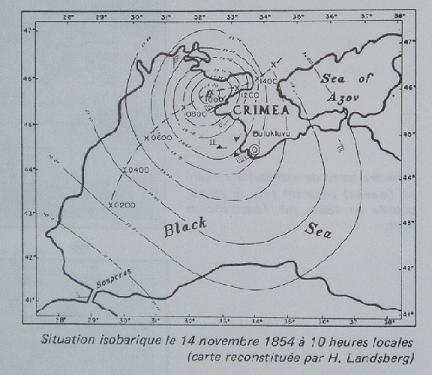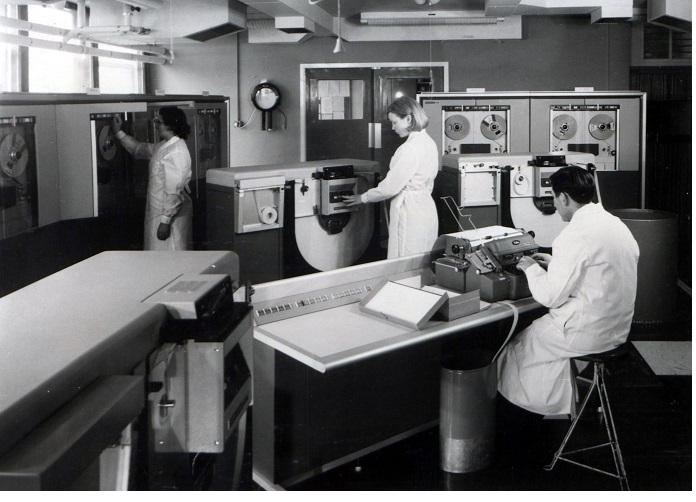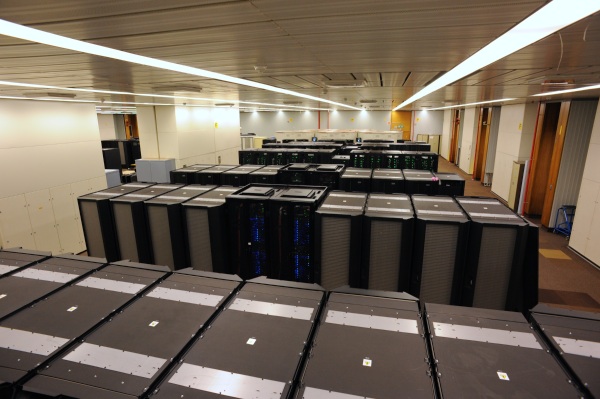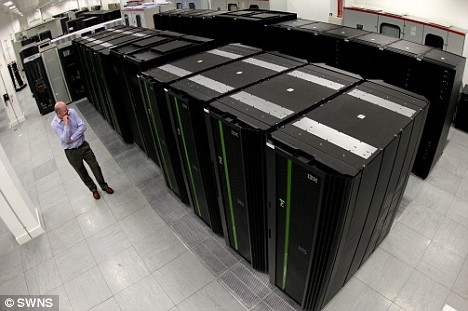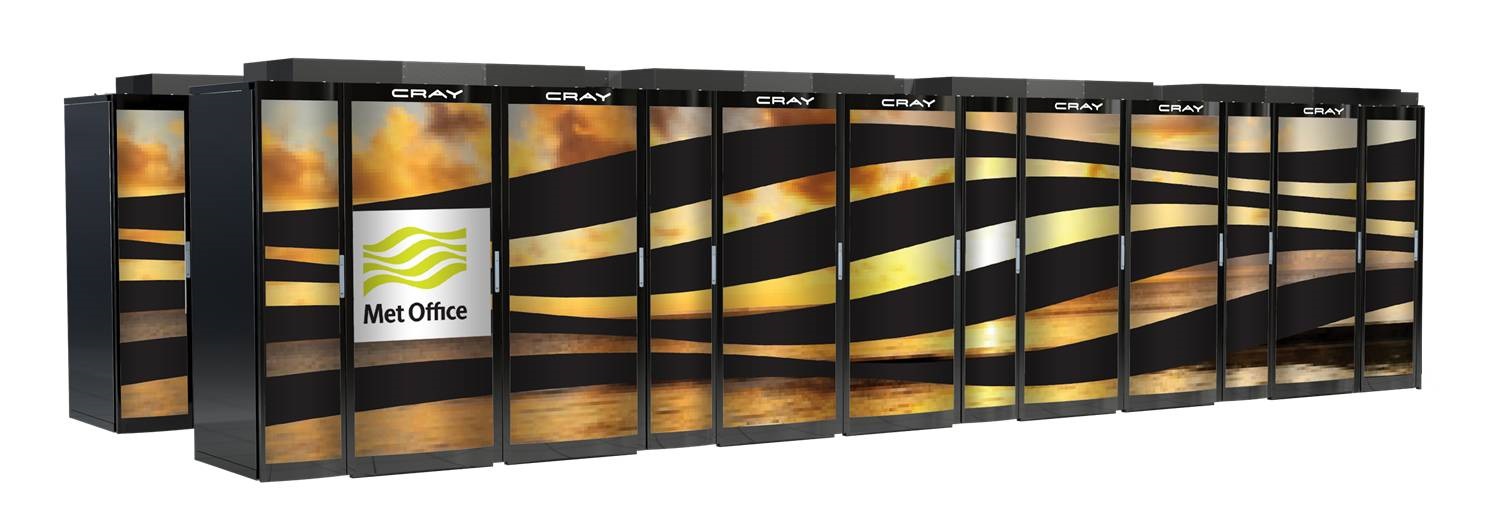About this page
The development of meteorology from time immemorial up to the modern hi-tech age of the super-computer.
Related pages
On this page -
- Weather and Man
- The Oldest Science
- Weather Long Ago
- Trying to Understand
- Observing and Measuring
- Trying to Understand
- Observing and Measuring
- The Approach to the Synoptic Approach
- International Co-operation and National Efforts
- Fitzroy - an Early Synoptician
- Technology
- The First Genuinely Scientific Approach
- Computers
- A brief chronology
Weather and Man
Just about every activity engaged in by man is dependent upon the weather or knowledge of the weather. Agriculture, transport of all forms, fossil fuel exploration, construction, maintenance of public utilities are obvious examples. Less obvious are helping in crime cases, verifying insurance claims, disease control of animals and plants, advertising campaigns, sales promotions, forward buying of coffee and cocoa. Battles have been won by or because of the weather. Alexander the Great won sea battle against the Persians by delaying his attack until the sea breeze set in a and put the enemy on a lee shore.
Drake singed the King of Spain’s beard by using the sea breeze to carry his fire ships to the Spanish fleet caught by the same wind on a lee shore. The Armada was defeated partly by Queen Elizabeth’s navy but a severe storm was a significant factor in scattering the Spanish fleet. The success of the D-Day landings owed not a little to the weather. The invasion was postponed for one day and then nearly postponed for a month but the Met Office predicted a narrow window of opportunity and Eisenhower took the advice. The German forecasters thought that the weather was too bad and the Luftwaffe had been stood down.
The Oldest Science?
Man has studied the stars, medicine and weather from time immemorial and which is the oldest science is a question akin to the argument about how many angels can stand on a pinhead. Like astronomy, meteorology is a physical science. In astronomy or, at least, the more obvious manifestations such as the behaviour of the planets and comets, one law of physics, that of gravitation, can explain everything that we see. This makes prediction, whether by observational experience or by calculation, straightforward and incredibly precise. Weather results from several simple physical processes that interact with each other in a complex manner making prediction infinitely more complicated and far from precise.
In meteorology, as in medicine, a diagnosis based on an incomplete set of data leads to a prognosis. The difference is that the physician can say that he wants a second opinion or ask the patient to come back next week. The meteorologist has to give a prediction by a deadline. A perfect forecast is useless if it is too late to be used.
Of the three sciences, medicine and meteorology are, we now know, more central to our everyday life than astronomy. Medicine can mend our life but weather shapes it. As W J Humphreys said -
What is it moulds the life of man? The weather. What makes some black, others tan? The weather. What makes Zulus live in trees, The Congo natives dress in leaves, While others go in furs and freeze? The weather.
That was, of course, written in an age when political correctness was not too important.
Weather Long Ago
The interest that man has taken in the weather has depended upon perceptions of his ability to predict it and use the predictions to his benefit. To the Babylonians, weather was predominantly seasonal in character and, because the march of the seasons could be related to the positions of the stars and solar elevations, they can be excused for assuming that the weather was governed by their stellar and planetary gods. Not surprisingly, their attempts to predict the weather were based on astronomical occurrences together with some fanciful ideas about the behaviour of animals. In the Egypt of the Pharaohs, life was critically dependent on the behaviour of the Nile. Perhaps strangely, they did not relate this to rainfall in the Sudan but worshipped the sun god, Ra and the river god, Isis.
It was civilisations in more temperate latitudes that began to make serious and organised study of the weather. By 1300 BC, the Chinese were able to produce weather summaries for a ten year period and by 1000 BC they had organised an observing network recording weather systematically. The Chinese were, even then, highly bureaucratic and used to make national decisions based on weather information. For example, should an army be deployed on a military campaign or go home to tend the crops and get the harvest in. Around the same time the civilisations based on the Indus river had a rain gauge network with, apparently, a standardised unit of measurement and, perhaps, a standard gauge.
The earliest known forecasts date from around 1000 BC in China. “If the wind is in the north and the skies clear, there will be a frost.” For a fruit grower this was as good a rule of thumb then as it is now.
Nearer home, the Greeks, around 700 BC, had a number of rules for weather prediction, what, nowadays, we would call weather lore. After all, this is simply a case of relating what is experienced at one time to what happens later - the starting point for most of science. Aristotle, around 350 BC, wrote his treatise Meteorologica, becoming the first person to use the word in writing. His disciple, Theophrastus, produced a collection of weather forecasting rules, many of which we know still. Red skies morning and night, haloes round sun and moon were well known as predictors.
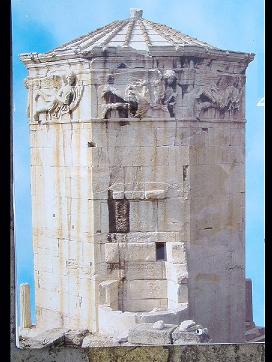
Tower of winds
The Tower of Winds, still standing in Athens, is eight sided with sculptures on each side showing the nature of the weather with winds from each direction. Even then it seemed sensible to use an eight point compass and not a six or ten point one, for example. It is significant that the most important god to the Greeks was Zeus, God of thunder. Later, the Scandinavians worshipped Thor.
Trying to Understand
Observing the weather was on matter, understanding it quite another. Christopher Robin was not alone in finding wind a mystery when he said -
Nobody tells me, nobody knows
Where the wind come from, where the wind goes.
Aristotle, Euclid, Pythagoras, Archimedes and the rest were not scientists as we understand the word. They were philosophers. That is, they did not conduct experiments but appealed to, apparently sensible, reasoning. For example, the earth was obviously the centre of the universe and the sun was observed to go around the earth. The experimental approach and the application of physical reasoning came much later with Galileo being one of the early exponents.
Perhaps Archimedes in the bath was an exception.
Aristotle’s explanations of rain, cloud and fog would be understandable to a modern schoolboy, if not accurate, but wind defeated him completely. It either came out of holes in the ground or from the breathing of plants.
Christopher Robin would have been justified in his complaint right up until the 19th century. Meteorological understanding virtually stood still for 2000 years and Aristotle’s book was regarded by many as the standard text for most of that time. In the 17th century, an Englishman attributed the constancy of the Trade Winds to the “exhalations from the weed in the Sargasso Sea”.
Observing and Measuring
Failure to understand notwithstanding, the need to collate and predict were obviously important. Weather records were kept in many countries. In England, for example, the Venerable Bede produced a weather diary in 700 AD. Europe was a long way behind China.
Observing methods continued to develop, particularly after 1000 AD when the Chinese and the Koreans normalised their rain gauges. In 1500 Leonardo da Vinci built a hygrometer using absorbent material the weight of which varied with the humidity. He also designed an anemometer. In 1592 Galileo constructed a thermometer using the expansion of air. In 1639 there was a standard pattern of rain gauge in Italy. Two years later a thermometer using alcohol was invented.
In 1644 Torricelli produced his mercury barometer and two years later, conforming to British preconceptions of the French, Pascal experimented with a barometer using wine. In 1661 the first Italian thermometers reached England. Within two more years, Christopher Wren had designed a rain gauge to measure hourly totals and Hooke formulated a system for logging the weather.
In 1667 temperatures began to be recorded at Oxford, the start of a long term series that is of great value in studying climate change. The British were catching up fast.
In the 17th century, there were the first, seriously scientific moves to try to explain the workings of the atmosphere and to reconcile observations with theory. Boyle discovered that the pressure, temperature and density of a gas were interrelated. It was realised that pressure falling to a low value could be followed by storms. Newton discovered refraction and, so, explained the rainbow. Halley produced charts of average winds over the oceans and deduced that pressure and wind were somehow interdependent.
In the 18th century, Hadley explained the existence of the Trade Winds as being due to the rotation of the earth. But, it was not until 1857 that Buys-Ballot enunciated his now famous law about standing with your back to the wind ..... But nobody told Christopher Robin.
The Approach to the Synoptic Approach
The 19th century saw the beginnings of a genuine, concerted scientific approach to meteorology although there were still some notable individual contributions. Luke Howard categorised clouds in 1802 using those now well known Latinised names such as cumulus, cirrus, stratus, cumulonimbus. Partly, this was to give scientific respectability to the subject, following the example of the botanists. In 1806 Commander Beaufort first defined his eponymous scale for describing wind. In 1836, his final version was promulgated by the Admiralty for mandatory use by all RN ships. The scale is still used by mariners and weather forecasters world-wide.
However, developments leading to a genuine understanding of the weather, and its prediction, have always depended upon technology. The first example was the electric telegraph, invented by Samuel Morse in 1836. Whether the possibility of collecting weather data virtually as it occurred over large areas sparked off meteorological thinking or whether the realisation of the requirement came first, is not clear. What is known is that, in 1839, John Ruskin, that most unlikely of meteorological thinkers, wrote that -
"The meteorologist is impotent if alone; his observations are useless; for they are made upon a point, while the speculations to be derived from them must be on space. It is of no avail that he changes his position, ignorant of what is passing behind him or before; he desires to estimate the movement of space, and can only observe the dancing of atoms; he would calculate the currents of the atmosphere of the world, while he only knows the direction of a breeze."
Ruskin was saying, in effect, that it is impossible to understand or forecast the weather on the basis of data from a single observer, whether stationary or mobile. Rather more prosaically - and succinctly, with some ellipsis - the Head of the UK National Met Centre, (aka the Central Forecast Office) said -
"In order to be able to forecast anywhere, you have to able to forecast everywhere."
It was not long (1842) before weather observations were being collected and published on a daily basis in national newspapers. At the 1851 Great Exhibition in London, one penny would buy a map of the British Isles with weather observations from Britain and Ireland.
International Co-operation and National Efforts
Losses of ships, at a time when world trade was increasing, led to Governments waking up to the idea that international co-operation in meteorology might pay useful dividends. The first International Meteorological Conference was held in Paris in 1853. The leading light, Lieutenant Maury, a beached US Navy Officer, proposed standard times, methods of observing and logging format for weather reports from ships at sea.
The observations were to be made available to national marine authorities and exchanged freely between nations. This process continues today with some 7000 merchant ships voluntarily observing the weather. Nowadays, most ships report in real time as well as returning weather logs (increasingly as computer files) to their national weather services. The Met Office marine archive now has getting on for 100 million observation from ships world-wide dating back mainly to the mid 1850s with a few (eg HMS Beagle) from earlier times. This archive is an invaluable tool for such purposes as risk analysis, climate definition and climate change studies.
With the means of collecting data in real time (at least over land) now well tried and tested, interest in meteorology was receiving official blessing. A catalyst for further progress was the 1854 Black Sea storm during the Crimean War. This sank a number of Allied ships, including a large French troop ship, the Henri V. The French Emperor, Louis Napoleon (Napoleon III), asked his Astronomer Royal, Le Verrier, to study the event and see if any lessons could be learned.
Le Verrier collected a great deal of information and was able to produce weather maps of wind and pressure. These showed that the storm was a circulation of winds around a central low pressure. Moreover, this had moved as an entity on a fairly steady course over a period of days. Le Verrier made the momentous deduction that forecasting was scientifically possible - at least in principle.
During the following few years, national weather services were created in many countries. The UK Meteorological Department of the Board of Trade (forerunner of the Meteorological Office) was the second, being pipped to the post by the Dutch.
Captain (later Admiral) Fitzroy, of HMS Beagle and Charles Darwin fame, was the first Secretary (Director) and was charged with “providing meteorological advice to the Royal and Merchant Navies.” Fitzroy put in hand the collection of data from ships as proposed at the 1853 conference. He co-ordinated observing networks over the British Isles, partly for climatological purposes, but also for real time use. Using the electric telegraph, he organised the collection of data from a small number of stations in the UK and, importantly, the exchange of data with other national weather services.
Black Sea storm
Fitzroy - an Early Synoptician
Fitzroy began to give warnings of severe weather in progress and initiated the issue of gale warnings to ships by means of cones flown from coastal locations. Fairly soon he had defined a set of forecasting rules, and started to predict gales. It was then a short step to starting to forecast weather generally. Not surprisingly, after all he had no real time information over the sea, he was not very successful and came under severe criticism, particularly from the scientific purists of the Royal Society. This preyed on his mind together with a feeling of guilt that, as a devout and conventional Christian of the time, he had some responsibility for Charles Darwin’s “heretical” views on evolution. Fitzroy committed suicide. But much useful groundwork had been done.
Fitzroy devised a system of internationally understandable number codes for exchanging information, and idea that survives to this day. He introduced the Stevenson screen to standardise the measurement of air temperatures. Coherent and co-ordinated observing networks had been initiated. The concept of daily forecasts published in newspapers to the general public had become accepted as a norm of everyday life.
Perhaps importantly, and not always appreciated, Fitzroy established the principal that forecasting only ever improves by trial in the real world. In other words, a new technique can be tested in the laboratory exhaustively but the warts only appear when it is used practically to give advice to real and critical users.
Technology
Since then, progress has occurred largely as and when developments in technology made possible the realisation of meteorological ideas and aspirations. In recent times, much of the impetus for the development of large, powerful scientific computers has come from the meteorological requirement.
Radio telegraphy made possible the collection of data from ships while at sea thus enabling synoptic charts to be analysed within a few hours of weather occurring. This led to the evolution of synoptic meteorology - the study of the weather as a whole, recognised by Ruskin to be necessary to understanding the atmosphere. Conversely, radio also allowed the provision of weather information to ships on passage.
Radio enabled the use of free flying balloons making soundings of temperature, pressure and humidity up to great heights. Radio theodolites and radar made it possible to track those balloons and, so, measure winds in the atmosphere above the ground. This led to the evolution of the understanding of the behaviour of the atmospheric in 3 dimensions. Nowadays, these radio sonde balloons often carry cheap, use-once-and-throw-away, GPS sets for the same purpose.
Radio (now often via satellite) allows the collection of data from aircraft, data buoys and other remote locations. Satellites, first, gave pictures of weather system development and, later, a largely indirect system of measurement. Satellites do not measure air temperatures and humidity directly but they do give information from which something about these parameters can be derived. Satellites are not, in themselves, sources of forecasts although they do have valuable observing and communications roles.
Last, and most importantly, computers are increasingly letting meteorologists estimate the effects of the many physical processes that result in weather. The concept was proposed in 1904 by the Norwegian physicist, Vilhelm Bjerknes. He said that the physical proceses of the atmosphere could be expressed in mathematical equation. These could calculate forwards in time to determine the state of the atmosphere. The first tentative steps to apply these ideas were by a British mathematician, Lewis Fry Richardson during WW1 while he was a stretcher bearer in France.. He made a trial calculation, by hand, of a six hour pressure change at one location in central Europe. Although he got the answer wrong by a factor of 100, he had defined the problem and proposed what was to become a standard technique.
Richardson envisaged a spherical shaped building, perhaps like the Albert Hall, with people sitting all over it using slide rules (remember those?) and mechanical calculators. A large spot light would slowly swing round to indicate where the sun would be shining. They would be calculating changes at their individual locations for a short time ahead. They would pass the results to their near neighbours and, using the new data, calculate for another short time ahead. Computer buffs will recognise this as parallel processing. Bjerknes and Richardson were both very far sighted and well ahead of their contempoaries in recognising the problem.
The First Genuinely Scientific Approach to the Problem
The first very crude computer predictions were made in 1950, in the USA, on a computer called ENIAC. Each new generation of computers has allowed, and is continuing to allow, further refinement of the estimates although it is unlikely that the calculations will ever be precise. Over the past 50 years computer predictions have improved to an extent whereby 5 day forecasts are routinely useful. In time, the useful forecast period can be expected to increase to, perhaps, 10 days. Short term forecasting will also improve, but their use will need significant improvements in methods of data dissemination if we sailors are to realise the benefits of the potential wealth of available weather information. The Met Office first used a computer owned by Lyons Teahouses (remember those?).
Next, they used a Ferranti development computer at Manchester University before buying a production model Ferranti Mercury. This could do an astounding (at the time) 3000 calculations per second. This commuted weather patterns over the Atlantic - Western Europe sector of the northern hemisphere at a grid length of some 320 km. Nowadays, modern weather services, such as the UK Met Office, use what are known as massively parallel processors (super-computers). The basic principle is as predicted by Richardson but the computers can do astronomically large numbers of calculations per second. I doubt that few scientists, even with the imagination of Richardson, would have thought, back in 1918, that their ideas would come to pass in such a spectacular manner. We now know that Richardson failed not because of any lack of understanding of meteorological physics. It was due to the lack of knowledge of numerical methods which only really developed with computers.
Meteorological computers.
For the computer buffs, this is a brief summary of the Met Office main computer facility. The system eoperating in 2005 had the power to make 1.5 Billion (1.5 Trillion in US terms) calculations per second. And we thought that the Ferranti Mercury was a marvel! It was possible to use a model grid length of about 60 km globally and 11 km over the North Atlantic/European area and down to 4 km for the UK and. later to 1.5 km. But, this is still not enough to calculate the effects of, say, Start Point! In 2010, the global model grid length was reduced to 25 km.
To put the problem into context I became a senior forecaster at Bracknell in 1967. At that time the afternoon forecast, based on midday data, was for “tomorrow” with an outlook for the next two days at most and sometimes only one day. Contrast that with the frequent and very useful extended outlooks covering a week and broadcast on TV and radio. I believe that is a true measure of what has been achieved so far.
By 2013 a super computer supplied by iBM will take computeing power nearly up to petaflop levels ie around 1015 floating arithmetic operations per second. Initially the system will have computing power roughly equivalent to 20,000 high-end PCs and is armed with 13 TB of memory and over 500 TB of disk storage. (One Terabyte = one million megabytes.)
In 2015, ECMWF then the Met Office installed massive Cray Supercomputers with speeds around 16 x 1015 flops(16 petaflops).
Met Office Computers 1959 to 2005
|
Year |
Computer |
Calculations/second |
|
1959 |
Ferranti Mercury |
3 x 104 |
|
1965 |
English Electric KDF9 |
5x104 |
|
1972 |
IBM 360/195 |
4x106 |
|
1982 |
Cyber CDC 205 |
2x108 |
|
1990 |
Cray YMP |
1x109 |
|
1991 |
2nd Cray YMP |
2x109 |
|
1994 |
Cray C90 |
1.2x1010 |
|
1996 |
Cray T3E |
6x1010 |
|
1999 |
2nd Cray T3E |
1.2x1011 |
|
2004 |
30 NEC SX-6 nodes |
7.2x1011 |
|
2009 |
NEC enhancement |
1.6x1012 |
|
2013 |
IBM Super Computer |
1.3x1014 |
|
2015 |
Cray XC40 |
16x1015 |
Ferranti Mercury, |
English Electric KDF9, |
NEC Computer |
|
ECMWF Computers |
Met Office computer, 2011 |
Met Office computer, 2015 |
Did Christopher Robin get the answers?
Christopher Robin eventually decided that he knew where the wind came from but not where it was going. Like Christopher Robin, we know whence meteorology has come, but we also have some idea of whither it is going although we cannot be at all sure just how far it will go.
A Brief and Very Selective Chronology of Meteorology through the Ages
1000 BC Chinese weather forecasts.
350 BC Aristotle writes his treatise, Meteorologica.
1400 AD China and Korea normalise rain gauges.
1592 Galileo invents a thermometer.
1644 Torricelli invents the mercury barometer
1667 Temperature records start at Oxford <>
1735 Hadley explains the Trade winds .
1802 Luke Howard categorises clouds.
1806 Beaufort introduces his wind scale, with his final version 30 years later.
1839 Ruskin defines the weather problem.
1848 Daily weather observations in newspapers
1854 The Black Sea storm
1855 Met Office formed
1857 Buys-Ballot enunciates his law.
1905 The first observations from ships by radio
1922 L F Richardson publishes book on numerical weather prediction.
1950 The first Numerical weather predictions using electronic computers.
1956 The Met Office gets its first Computer (Ferranti Mercury)
1960 The first weather satellite.
1967 The UK starts to use computer forecasts operationally.
1981 First global weather predictions by The Met Office with its first supercomputer
1990 The Hadley Centre for Climate Prediction and Research opened.
This page is an updated version of an article published in the annual newsletter of the Hallberg Rassy Owners Association and then in Cruising, the magazine of the Cruising Association .

